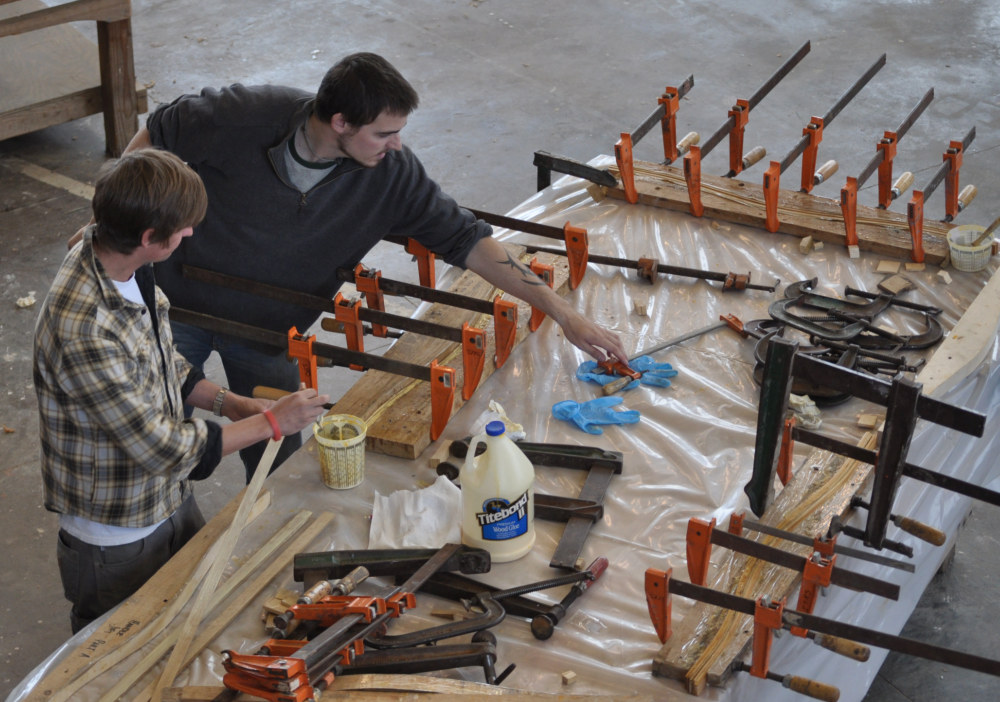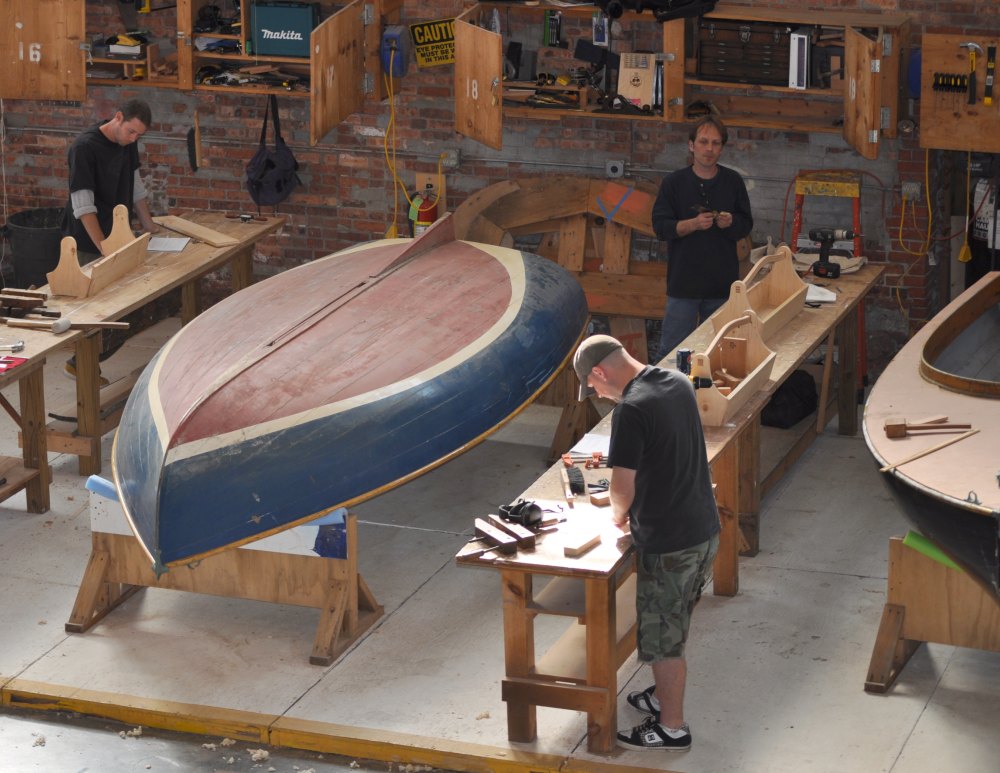Shaping Boats, and the Industry

Puzzling the problems of the day. Photo by KL
Walking through door of the International Yacht Restoration School will likely affect you considerably.
Speaking from experience.
But I’ll let Jens Lange tell it his way. Jens is a grownup who had a successful but less-than fulfilling 18-year, Europe-based career in the auto industry that had him jetting around the world earning pretty good money. He was also a sailor who sailed Nordic Folkboats and had a thing for wood and—
“I read an article about this place. I read it more than once. It sat on my desk for months. Finally I had business close by, and that was an easy opportunity. I walked in, I smelled the boatyard smells, I loved the atmosphere, I was hooked.”
Jens left his job and went back to school, graduating on June 5, 2010 from the two-year Boatbuilding and Restoration Program at the International Yacht Restoration School, which going forward we’ll call IYRS, and which you might as well know the in-crowd pronounces as in the flower “iris.” Picture a huge facility on the waterfront of Newport, Rhode Island, with light filtering in from high overhead, encouraging a sense of spirituality amongst an assortment of tools and parts and materiel that will eventually become boats—or become boats again—and altogether this might be taken for clutter, but it is not that. IYRS is not the only school in the USA that is teaching the woodbutchers’ craft, but it is a leader. If you’re into this sort of thing you will know a cathedral when you see one.
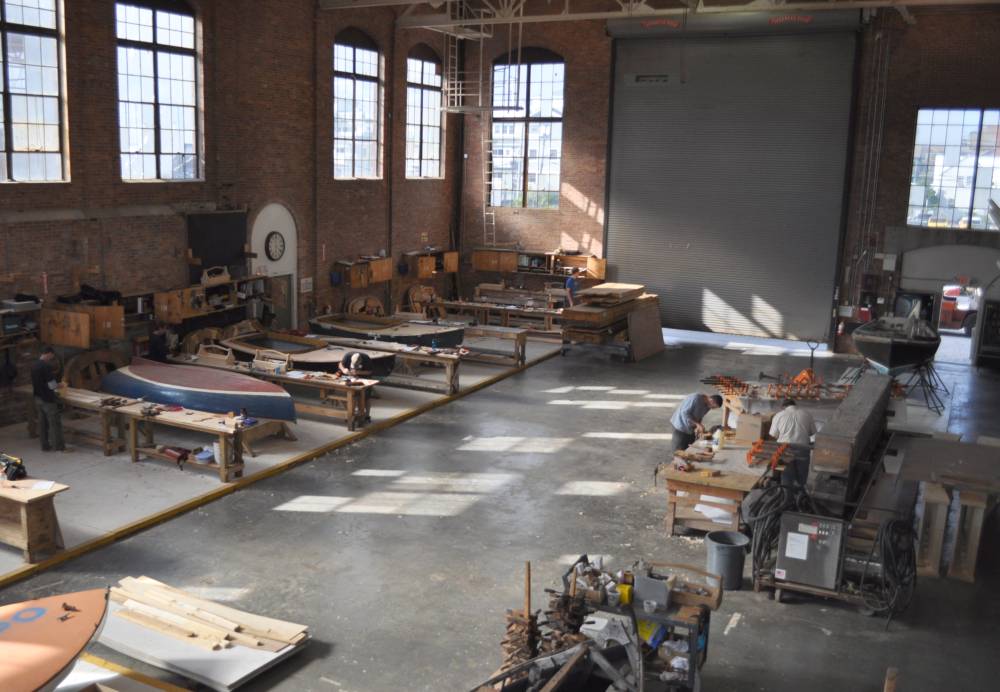
A quiet floor with most students in lecture. Photo by KL
Hand it to Jens. He says, “I left the auto industry two months before the whole thing went bonkers. In the present economic situation, this has been the perfect place to hide.”
Besides which, he’s doing what he wants to do.
Besides which, he’s doing it in a special atmosphere that has delighted thousands of visitors. If you’re in Newport, you should visit IYRS. It’s free, the experience is there waiting, and you won’t be sorry.
IYRS likes to describe its mission as “shaping the people who shape the industry.” That’s lofty, but without a doubt the school addresses the need for skilled marine professionals who understand both the business side and the craft. Along with building and restoration in Newport, the school has been teaching a one-year Marine Systems curriculum in a facility in Bristol, preparing students to sit for the ABYC certification exams, and this year it is launching a Composites Program that integrates the skill sets one step further. IYRS needs additional programs, probably, to become a self-sufficient teaching institution not dependent on philanthropy, and that’s the goal. Even if it succeeds there, IYRS will continue to solicit boats to be restored by the students, which then are sold to help keep the lights on. Some beautiful work has come out of this place where they espouse, “preservation through use.”
IYRS attracts a spectrum of students, as described by Jens’ fellow 2010 graduate, Bobby Cutler, who puts it this way: “One kid is a second-generation cabinet maker; another had been into building surfboards, and other kids have never picked up a tool in their lives. They’re all ages, all backgrounds, different nationalities. We get along because we share a love of working with our hands.”
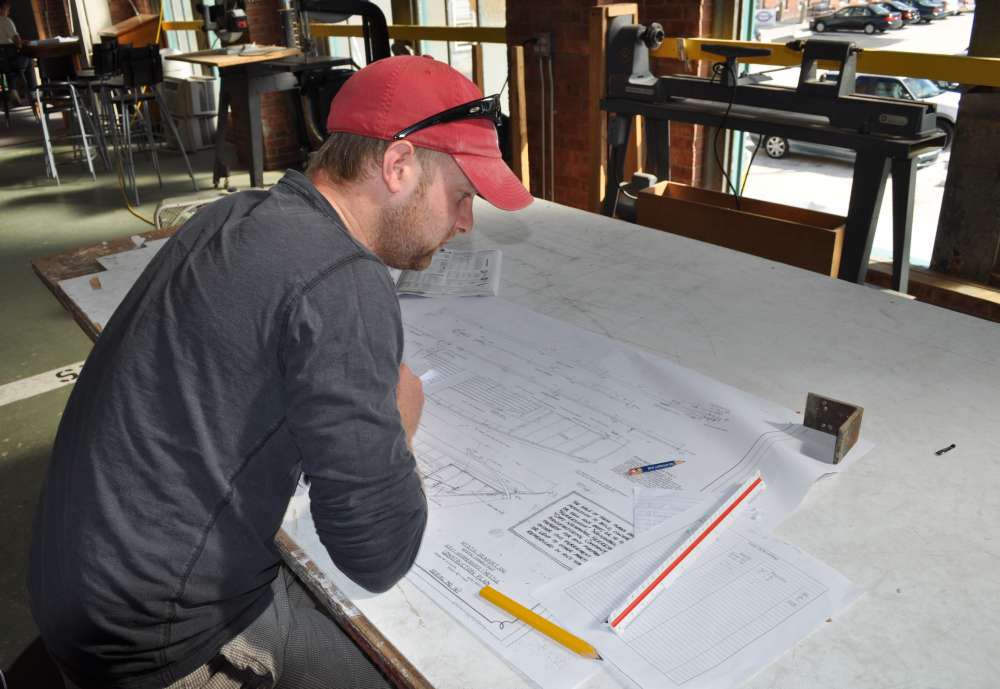
Bobby Cutler and his project. Photo by KL
Bobby is our focus for this segment of the story because he is, himself, a story, someone from a college-expectations family who tried a few “but it didn’t work out” and was searching for something. “I couldn’t sit still in a classroom,” he says, and points to a nearby room where lectures are given, “even that is a nightmare for me.”
Bobby hails from the idyllic rural community of Harvard, Massachusetts (not to be confused with the university): “My dad is a developer. He tells me now he wishes he could have gone to this school. If you can build a boat, you can build anything.”
The two-year Boatbuilding and Restoration Program in its first year addresses hull measurement, lofting, drafting, half-model making, and the restoration of a small plank-on-frame sailboat (where “restoration” includes documentation, backbone construction, steam bending, planking, spar building and finish work). The second year builds upon those skills with a more demanding project on a larger boat and, importantly, teaches the skills for success on the business side. By way of project management, the student estimates a job, Cutler says, and that involves “every single fastener, rivet, bronze rod, the dimensions of every piece of wood, the type of wood, the lofting, the pencils that you’re going to use, the paintbrushes you will use for painting, labor costs, shop hours including selecting stock and milling to dimension, contract agreements—it’s kind of a nightmare.”
An approximation of the real-world nightmare, obviously, that lays bare the differences when one student estimates a job at $40,000 and another at $70,000.
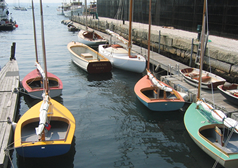 “Students start with a Beetle Cat,” Cutler says, “and that gives you a pretty good idea of how things are done. Then comes the Herreshoff 12.5, which has tighter joinery and a higher level of finish. There’s no room for filler, no room for mistakes. And we loft out the 12.5 even though, technically, we don’t have to.”
“Students start with a Beetle Cat,” Cutler says, “and that gives you a pretty good idea of how things are done. Then comes the Herreshoff 12.5, which has tighter joinery and a higher level of finish. There’s no room for filler, no room for mistakes. And we loft out the 12.5 even though, technically, we don’t have to.”
(IYRS will sell you a restored Beetle Cat for $11,500 in “appropriate colors”.)
For his graduation project, Cutler worked on a lovely little Gar Wood that had pretty much left this world. “The boat came to us in pieces,” he says. “We kept the hardware, some engine parts, the benches.”
Then came the other 98 percent. The early project phase looked like this.
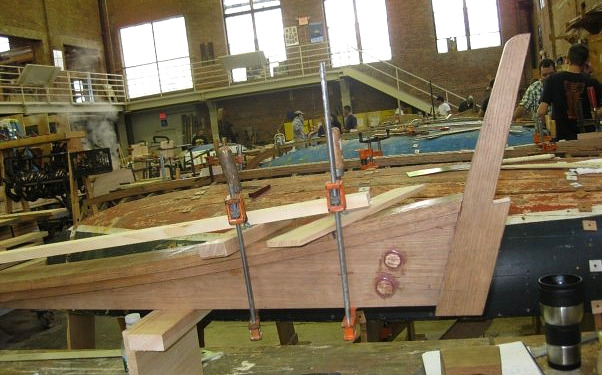
The beginnings of a 98% restored Gar Wood. Photo courtesy of Bob Cutler
Cutler had grown up with motorboats, so a 21-foot Gar Wood was a logical choice (for his nephews, he had already built a pair of “boat cribs” that should be around for generations). Next year he wants to come back for the new Composites Program. “I love working with wood,” he says, “but I’m also intrigued by high technology in boatbuilding. If I have both skills, I’ll be twice as valuable.”
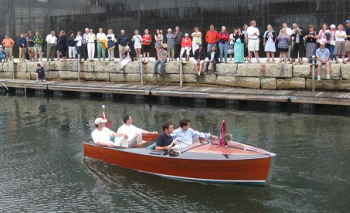 Speaking of graduation day, and Gar Woods—and some late nighters, coming down to the wire—how many schools are there, besides the International Yacht Restoration School, where graduation day means launching boats, and setting forth in those boats? Nothing metaphorical, a literal setting forth. They either float or they don’t.
Speaking of graduation day, and Gar Woods—and some late nighters, coming down to the wire—how many schools are there, besides the International Yacht Restoration School, where graduation day means launching boats, and setting forth in those boats? Nothing metaphorical, a literal setting forth. They either float or they don’t.
Find the International Yacht Restoration School on Thames Street in Newport, or online at iyrs.org. Next, a view from the admin side.

